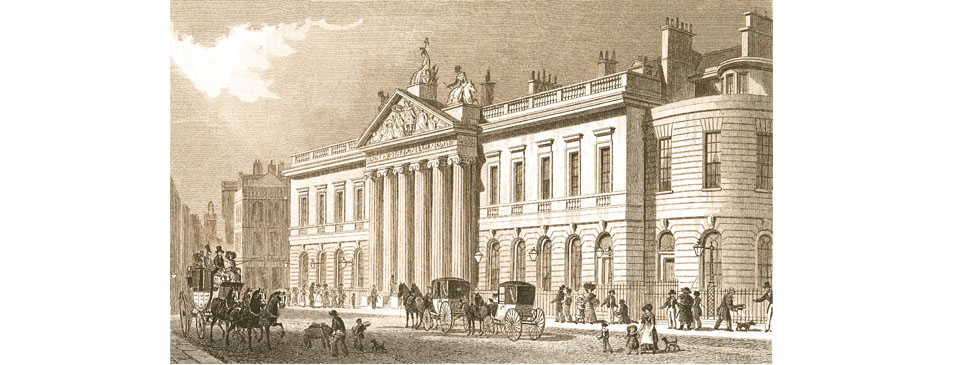The East India Company

East India House in Leadenhall Street in the City of London. The Company had occupied the site since the mid-17th century but expanded several times. This building was designed by Henry Holland and work began in 1796. It included a museum housing the Company’s collection of exotic items. The building was demolished in 1862 following the Company’s demise and is now the site of the Lloyd’s insurance building. The drawing is by T.H. Shepherd and published in 1829.
For a century the India the East India Company was an unusual organisation. Primarily a London-based trading company that worked for the benefit of its shareholders, it governed vast areas of the Indian sub-continent and employed a large military. In order to provide a degree of accountability and combat corruption within the Company the government passed the India Act in 1784. The charters that provided the East India Company with its monopolies on business with India and China were renewed by the British government every 20 years. By the time the India charter came up for renewal in 1813 there were many calling for the liberalisation of trade and the monopoly of 200 years was finally ended. Thereafter the Company continued to govern in India as an agent of Parliament. The China monopoly similarly ended in 1833. The East India Docks were sold off and the City warehouses auctioned. East India House was demolished in 1861.
In 1857 the Company’s Bengal Army mutinied, leading to a general uprising in India. The savage war lasted for two years, after which Parliament decided it was time for a change in the governance of the sub-continent. The East India was stripped of its administrative powers and replaced by the British Raj, managed from the magnificent new India Office in Whitehall. Queen Victoria was given the title of Empress of India and the Company’s forces became the British Indian Army.
During its near 260-year existence the Honourable East India Company – often called ‘John Company’ – went through four phases. First it brought spices directly from the Far East. In its second phase it revolutionised the fabric industry, bringing cheap, quality cottons and silks to Britain. Next it changed the drinking habits of the nation, with tea from China. Finally, it ceased to be a commercial operation but continued as the administrator of large parts of the Indian sub-continent. At its best it was highly-efficient and the world’s largest trading organisation, directly employing 4,000 workers in London alone. Yet the large-scale corruption and its voracious appetite for excessive profits without accountability led to the plundering of the Indian economy and the near-enslavement of the native people, and opium addiction of huge numbers of Chinese. To this day, Bengal, once one of the wealthiest regions of the world, remains ones of its poorest.
Sources include: Nick Robins ‘The Corporation That Changed The World; Roger Williams ‘London’s Lost Global Giant’; l.H. Roper ‘Advancing Empire’; Sir Joseph Broodbank ‘History of the Port of London’; Fiona Rule ‘London’s Docklands’; Ian Friel ‘Maritime History of Britain and Ireland’; Samuel Pepys diaries; Daniel Defoe ‘A Tour Through The Whole Island of Great Britain; John Keay ‘A History of India’; Miranda Kaufmann ‘Black Tudors’; Robert Brenner ‘Merchants and Revolution’.
< Back to The Port of London


